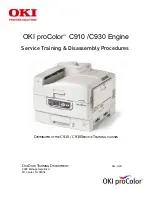
1 – 4
Chapter 1 Troubleshooting
1.4 Cautions for FIP Use
1) The FIP makes the assumption that the printer controller (PWBA ESS) is functioning normally. If
the problem cannot be corrected by using the FIP, replace the printer controller with a new one and
check for proper operation.
If the trouble is not still corrected, replace the major parts and then related parts in succession and
confirm according to the procedures of the "Initial check" and "Major check parts".
2) When troubleshooting using the FIP, parts substitution of the HVPS/MCU, FUSER ASSY, BTR
ASSY or other parts may be necessary for fault isolation. Have these parts available in advance.
3) The initial checks in the FIP only checks items which are most likely to cause the problem and can
be quickly eliminated.
4) Check both the major parts as well as any related sub-components in the initial checks.
5) When working with the printer, be sure to remove the power cord. If a check requires the power to
be connected, never touch any live parts.
6) Connector condition is denoted as follows:
[P/J12]
→
Connector (P/J12) is connected.
[P12]
→
Plug side of the connector (P/J12) removed (except when attached directly to the board).
[J12]
→
Jack side of the connector (P/J12) removed (except when attached directly to the board).
7) [P/J1- 2(+) and P/J3-4(-)] in the FIP means taking a measurement with the plus side of the meter
connected to [P/J1, Pin 2] and the minus side to [P/J3, Pin 4].
8) [P/J1 -> P/J2] in the FIP means measurement for all terminals corresponding between [P/J1] and
[P/J2] as shown in the "Wire connecting diagram".
9) In [P/J1- 2 (+) and P/J3-4 (-)] in the FIP where voltage is measured, [P/J3-4 (-)] is always at the AG
(analog ground), SG (signal ground), or RTN (return).
Therefore, after verifying ground between AGs, SGs, or RTNs respectively, the minus side can be
connected to the PIN of AG, SG or RTN instead of [P/J3-4 (-)].
However, care should be taken not to mistake since [AG], [SG], and [RTN] are not on the same
level.
10) Measure the voltage of small connectors with the special tool. Handle the tool with care, as the
leading edge of the tool is pointed.
11) When measuring a voltage, ensure that the EP CARTRIDGE, BRT ASSY and paper tray are prop-
erly seated. Close the COVER TOP ASSY, FUSER ASSY, and COVER REAR and switch the
printer power ON.
12) Voltages in the FIP are nominal. If the values fall within a tolerance of +/- 10%, they should be con-
sidered acceptable.
13) Parts which are routinely checked, as indicated in the FIP, and without any specific removal proce-
dures, should be handled carefully.









































